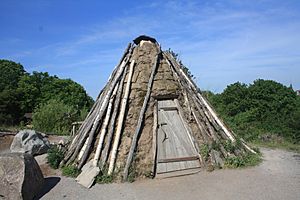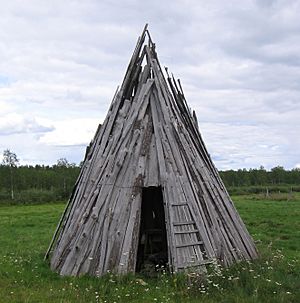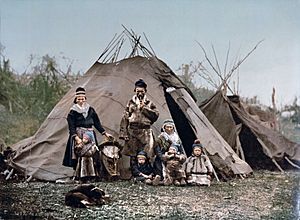Goahti facts for kids

A goahti (pronounced GWAH-tee) is a special type of hut or tent used by the Sámi people. The Sámi live in the northern parts of Scandinavia and Russia. A goahti is a traditional home designed to be either moved easily or built to last a long time. Sámi people have different names for it, like goahte, gåhte, gåhtie, or gåetie, depending on their specific language. These unique homes can be made from different materials: fabric, peat moss, or wood.
Contents
Discovering the Goahti: A Sámi Home
What is a Goahti?
The goahti is a traditional dwelling that has served the Sámi people for centuries. It's more than just a shelter; it's a central part of their culture and way of life. While some goahthis are like sturdy tents, others are built to be permanent homes. The fabric goahti might remind you of another Sámi tent called a lavvu, but it's usually a bit larger. It also has a more stretched-out, oval shape, sometimes called a 'bread box' lavvu. The lavvu, on the other hand, is typically round.
How a Goahti is Built: Poles and Coverings
Building a goahti involves a clever system of poles. Imagine four strong poles, each about 8 to 12 feet (2.4 to 3.7 meters) long, that curve at one end. These curved poles form the main frame. They are joined together at the top by a straight, horizontal pole, about 5 to 8 feet (1.5 to 2.4 meters) long. This creates a sturdy, four-legged structure that stands about five to eight feet tall.
Once the main frame is up, about ten to twelve more straight poles, called "wall-poles," are leaned against it. These poles help create the shape of the walls. Finally, a covering is placed over this pole structure. Today, this covering is often made of strong canvas fabric. Sometimes, more than one layer of covering is used to keep the inside warm and dry.
Fabric Goahti vs. Peat Goahti
The type of covering makes a big difference in how a goahti looks and feels.
- Fabric Goahti: This version uses canvas or other strong fabrics. It's lighter and easier to take down and set up. This makes it suitable for people who need to move often.
- Peat Goahti: For a more permanent home, the fabric is replaced with wood. This wood rests on the pole structure. Then, layers of birch bark are added, followed by thick layers of peat (a type of soil made from decayed plants). This creates a very strong, insulated, and durable building that can withstand harsh weather.
A key way to tell a goahti from a lavvu is by looking at the top. In a lavvu, all the poles meet together at a single point at the top, like a cone. In a goahti, the main poles stay separate at the top, forming a more open, rectangular space for the smoke hole.
Life and Travel with the Goahti
For many years, the Sámi people were nomads. This means they moved from place to place, often following their reindeer herds. When they traveled, they would take their goahti apart. Their domesticated reindeer would help carry or drag the poles and coverings. This allowed families to have a home wherever they went.
However, carrying the curved poles of a goahti can be a bit tricky. Because of this, today, when Sámi people need a portable shelter for camping or following traditions, they often choose the lavvu instead. Its straight poles are easier to transport.
In areas near the coast, some Sámi families lived in peat goahthis that were built to last. These sturdy homes were used for both people and their livestock (farm animals) until the Second World War. They provided a warm and safe place for families and their animals to live together.
See also
- Lean-to
- Tipi
Images for kids





